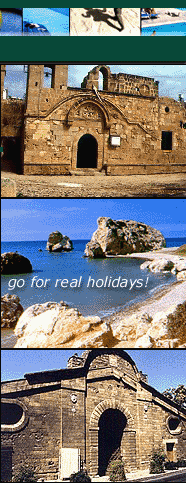|
7000-3900
B.C.- Neolithic Age
The oldest settlements found on the island date from this period. Stone
vessels and later, pottery was used.
3900-2500
B.C.- Chalcolithic Age
Chalcolithic settlements and evidence of a fertility cult, have been
found in Western Cyprus. Copper discovered.
2500-1050
B.C.- Bronze Age
Cyprus was known as
“Alasia” during this great trading period with its neighbors, partly
because of its exploitation of copper. After 1400 B.C., the first of
many waves of Greek merchants and settlers (Mycenaeans and Achaeans)
reached the island, spreading the Greek language, religion and customs.
They gradually took control and established the first city-kingdoms.
1050-750
B.C.- Geometric Period
The Hellenization of Cyprus was complete, with ten city-kingdoms. The
cult of Aphrodite flourished in a period of great prosperity.
750-325
B.C.- Archaic and Classical Period
An era of prosperity and conquest. Cypriot kingdoms became tributary to
Assyria, Egypt and Persia. But King Evagoras (411-374) unified the
island, making it an important center of the Greek world.
333-325
B.C.
Alexander the Great, King of Macedonia, takes Cyprus as part of his
empire.
325-58
B.C.
Hellenistic Period. Alexander’s generals
fought for succession, and Cyprus eventually came under the Hellenistic
state of the Ptolemies of Egypt, belonging from then on to the Greek
Alexandrine world. Pafos became capital.
58-B.C.-330
A.D.
Roman Period. Cyprus became part of the
Roman Empire. But Saints Paul and Barnabas converted the Roman proconsul
to Christianity, and he became the first Christian ruler in the world.
In 313 freedom of worship was granted, and Cypriot bishops attended the
council of Nicea in 325. The period was marked by earthquakes that
required the rebuilding of cities.
330-1191
A.D.
Byzantine Period. After the division of
the Roman Empire, Cyprus became part of Byzantium, with Christianity
becoming the official religion. Empress Helena visited the island and
founded the Stavrovouni Monastery. The period again saw earthquakes and
rebuilding, including large Basilicas. In 488, after the discovery of
St. Barnabas’ tomb, the Church of Cyprus was granted full autonomy by
Emperor Zeno. In 647 the first of a series of Arab raids occurred. The
raids went on until 965, when Arabs were expelled from Asia Minor and
Cyprus.
1191-1192
Richard the Lion-Heart and the Knights
Templar. Richard, leader of the Third Crusade, took possession of Cyprus
and married Berengaria of Navarre, crowning her Queen of England. A year
later he sold Cyprus to the Knights Templar who resold it to Guy de
Lusignan, deposed King of Jerusalem.
1192-1489
Frankish (Lusignan) Period. The Catholic
Church officially replaced the Greek Orthodox Church, but the latter
managed to survive. The city of Famagusta became one of the richest
cities in the world in this period, which ended when the last queen
Catherina Cornaro ceded Cyprus to Venice in 1489.
1489-1571
Venetian Period. The Venetians fortified
the island against the Ottomans, building formidable walls around
Nicosia and Famagusta, where the defenses were considered works of art
in military architecture.
1571-1878
Ottoman Period. Cyprus fell to the Ottoman
troops after much bloodshed. The Latin leadership was expelled and the
Orthodox Church restored, with the Archbishop becoming the people’s
representative to the Sultan. When the Greek War of Independence broke
out in 1821, many prominent Cypriots, including the Archbishop, were
executed. During this period a proportion of Cypriots and Latins
succumbed to pressures and converted to Islam, thus creating the Muslim
minority.
1878-1960
British Period. In 1878 Britain assumed
administration of the island, subsequently annexing it in 1914, after
the Ottomans entered the First World War on Germany’s side. In 1923
under the Treaty of Lausanne, Turkey relinquished all rights to Cyprus,
and in 1925 Cyprus became a Crown Colony. During the Second World War,
Cypriot volunteers served in the British forces. Hopes for
self-determination by the Cypriot people however, were denied by the
British, who considered the island strategically vital. A national
liberation struggle began in 1955 against Colonial rule and for the
union of Cyprus with Greece, which lasted until 1959.
During
the occupation of Cyprus by the Ottoman Turks from 1571-1878, a large
Turkish community was established which now makes up to 18% of the
population. The two communities lived peacefully on the island
throughout the years of British rule (1878 to 1960).
1960-
The Republic of Cyprus
Cyprus became an independent
republic in 1960, and a member of the United Nations, the Council of
Europe, the Commonwealth and the Non-Aligned Movement. Britain, however
retained two sovereign bases. The given Constitution of the Republic
proved unworkable, and in 1963 the President proposed some amendments.
The Turkish Cypriot community responded with rebellion. Turkish Cypriot
Ministers withdrew from the Cabinet, and Turkey threatened with
invasion. Since then, the Turkish Cypriot leadership, acting on
instructions from Turkey, has aimed at the partition of Cyprus and its
annexation to Turkey. Using as a pretext a coup instigated by the Greek
military junta against the Cyprus Government in July 1974, Turkey
invaded and captured 37% of the island, violating all principles
governing the UN Charter. As a result, approximately 40% of the Greek
population were violently uprooted and are, to this date, deprived of
the fundamental right of returning to their homes and properties.
Repeated Security Council and General Assembly UN Resolutions have
failed to convince Turkey to withdraw its troops. Moreover, more than
85,000 settlers have moved from mainland Turkey to the occupied area,
while in 1983 the Turkish Cypriot leader declared the so-called
“Turkish Republic of Northern Cyprus”, an illegal regime recognized
by no country except Turkey. Despite repeated rounds of talks, a
solution has not yet been found, and Turkey maintains the island’s
division by the force of arms.
For the last 26 years efforts are being
made to achieve a solution but they have been unsuccessful.
Towards
2000
Culturally a Western nation, Cyprus
expects to become a full member of the European Union by the turn of the
century.
|


